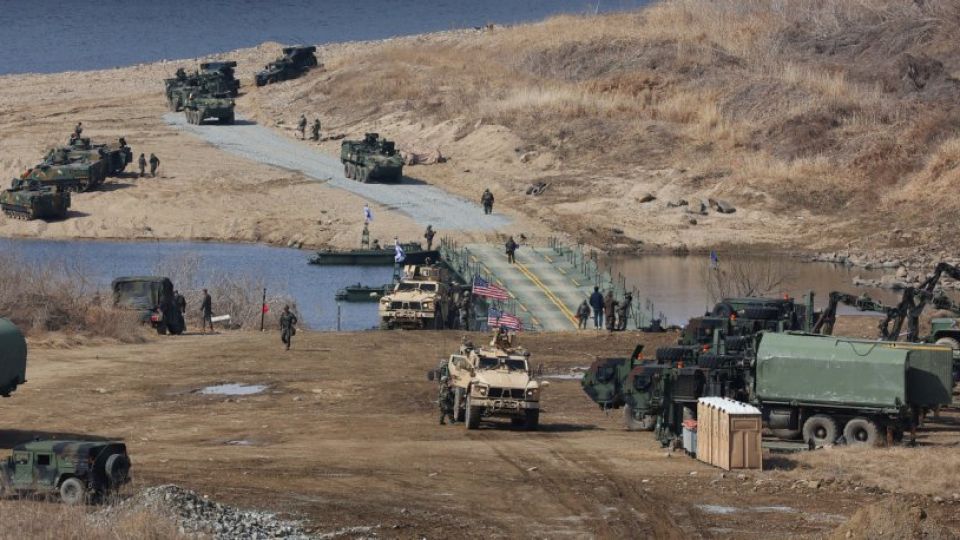March 14, 2023
SEOUL – South Korea and the United States on Monday kicked off their longest-running, large-scale military exercises re-designed to strengthen defense and response capabilities against escalating threats from North Korea. In response, Pyongyang disclosed its first-ever underwater cruise missile launches on Sunday, raising the curtain on military actions which it had repeatedly warned.
Amid North Korea’s accelerating military build-up, the Freedom Shield exercise continues for 11 days without a weekend break to enable South Korea and US troops to enhance their combat readiness and combined defense posture under real war conditions.
Freedom Shield presents real-world scenarios in light of ever-changing security environments including North Korea’s advanced missile and nuclear capabilities, as well as lessons from the war in Ukraine, according to South Korea’s Joint Chiefs of Staff.
“The combined military exercises are staged based on the South Korea-US operation plans in order to defend South Korea from the invasion of North Korea and therefore the exercises are defensive in nature,” said the JCS.
JCS spokesperson Col. Lee Sung-jun said the “South Korea-US alliance will stage the Freedom Shield exercise without a hitch even though North Korea seeks to interrupt military exercises by conducting provocations such as missile launches.”
The Freedom Shield exercise covers every stage of war on the Korean Peninsula, including crisis management, transition to war and defending the peninsula from North Korean attacks. South Korean and US troops also practice conducting counteroffensive operations and stabilizing the North Korean situation.
Seoul and Washington have also brought back theater-level field training exercises after a five-year hiatus. The allies have agreed to stage around 20 field training exercises or FTXs, including amphibious landing drills, in connection with the Freedom Shield exercise.
North Korea’s propaganda outlet Uriminzokkiri on Monday said the ongoing Freedom Shield exercise shows an unprecedented, “extreme level of belligerence” in terms of scale and exercise scenarios.

A “strategic cruise missile” is fired from the 8.24 Yonggung submarine of North Korea in the waters of Kyongpho Bay in the East Sea at dawn on March 12, 2023, in this photo released by the North`s official Korean Central News Agency (KCNA). The North launched two strategic cruise missiles from the submarine as it conducted an underwater drill on the eve of the Freedom Shield exercise, a regular South Korea-U.S. combined military exercise. (Yonhap)
On the first day of Freedom Shield, North Korean state media reported that the country fired two submarine-launched cruise missiles or SLCMs for the first time early Sunday, in waters off Kyongpho Bay in the East Sea, in an apparent move to begin a widely expected spate of military actions.
North Korea has threatened to take tit-for-tat actions against annual springtime military exercises between the allies.
North Korean state media claimed that “two strategic cruise missiles” were launched from the 2,000-ton class 8.24 Yongung submarine as part of live-fire drills, suggesting that the country fired operational, dual-capable cruise missiles capable of delivering both conventional and nuclear payloads.
“The underwater live-fire drills clearly showed the invariable stance of the Korean People’s Army to persistently control and manage the current situation, in which anti-DPRK military maneuvers of the US imperialists and South Korean puppet forces have been becoming flagrant, with overwhelming and powerful strength,” state media reported in a Korean-language dispatch, referring to the acronym of the country’s official name, Democratic People’s Republic of Korea.
The exercise also “proved the constant operational readiness of nuclear war deterrent in various spaces.”
The missiles traveled around 1,500 kilometers for nearly two hours and six minutes and hit a target in the East Sea, North Korean state media reported.
South Korea’s JCS on Monday confirmed that North Korea fired two cruise missiles from a submarine in waters in the vicinity of the port city of Sinpho in South Hamgyong Province on Sunday morning.
But during a closed-door briefing, South Korean military officials on condition of anonymity said that North Korean state media seems to be bluffing on the country’s cruise missile launches, except for correctly stating the platform and location of the missile launches and the number of fired missiles.
The assessments of the South Korean and US intelligence authorities on the specifications of the fired SLCMs, including travel distance and time, differ from the North Korean media report.
The JCS added that South Korea and the US have been analyzing the situation when asked whether the SLCMs fired on Sunday can carry nuclear weapons and whether North Korea has miniaturized nuclear warheads small enough to fit on the missiles.
The military officials also dismissed North Korea’s claim that SLCMs have been deployed in battlefields.
North Korean state media said the live-fire drills “aimed to confirm the reliability of the weapon system and examine and assess the readiness of underwater-to-ground attack operations of submarine units, which is another important component of the DPRK’s nuclear deterrent.”
“North Korea has not deployed missiles of this type. We’ve assessed that North Korea carried out early-stage test-firing of the missiles … (before deployment),” one South Korean official said during the briefing. “North Korea test-fired missiles as its winter training exercises have entered the final stretch and South Korea-US military exercises have kicked off.”
The missile launches came on a day when North Korean state media reported that the country has determined significant, practical steps to offensively and forcefully use its “war deterrent” in response to the Freedom Shield exercise at a key military meeting convened by North Korean leader Kim Jong-un.


